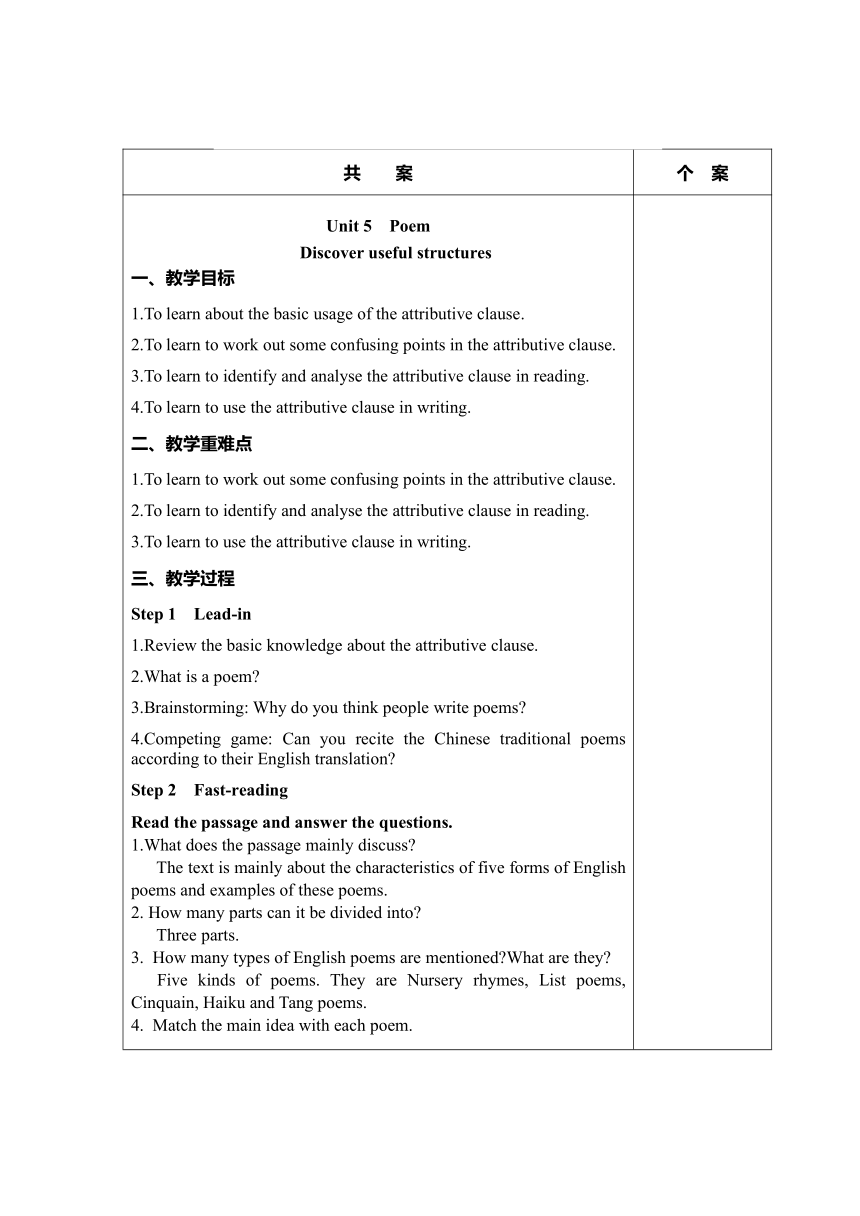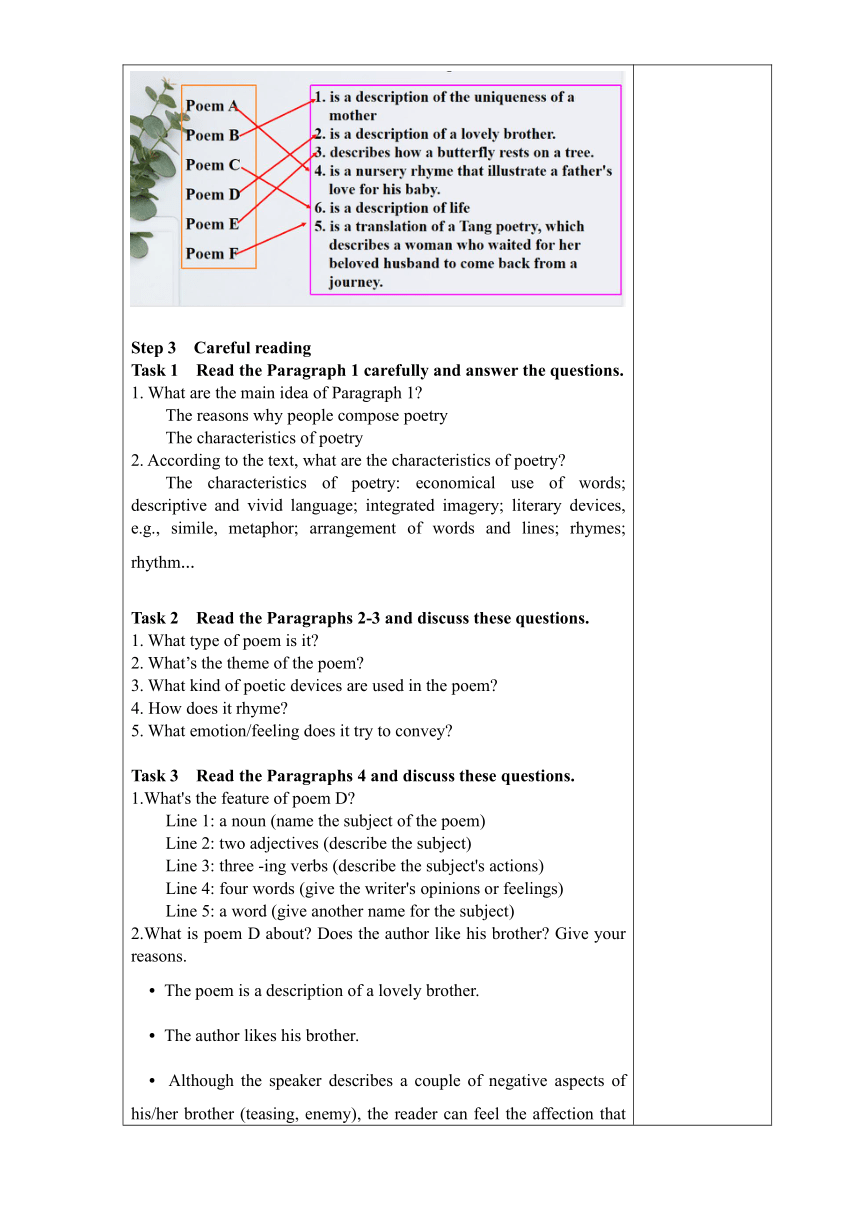人教版(2019) 选择性必修第三册 Unit 5 Poems Reading and thinking教案(表格式)
文档属性
| 名称 | 人教版(2019) 选择性必修第三册 Unit 5 Poems Reading and thinking教案(表格式) |  | |
| 格式 | doc | ||
| 文件大小 | 650.5KB | ||
| 资源类型 | 教案 | ||
| 版本资源 | 人教版(2019) | ||
| 科目 | 英语 | ||
| 更新时间 | 2022-03-31 13:04:24 | ||
图片预览


文档简介
共 案 个 案
Unit 5 PoemDiscover useful structures教学目标1.To learn about the basic usage of the attributive clause.2.To learn to work out some confusing points in the attributive clause.3.To learn to identify and analyse the attributive clause in reading.4.To learn to use the attributive clause in writing.二、教学重难点1.To learn to work out some confusing points in the attributive clause.2.To learn to identify and analyse the attributive clause in reading.3.To learn to use the attributive clause in writing.三、教学过程Step 1 Lead-in1.Review the basic knowledge about the attributive clause.2.What is a poem 3.Brainstorming: Why do you think people write poems 4.Competing game: Can you recite the Chinese traditional poems according to their English translation Step 2 Fast-readingRead the passage and answer the questions.1.What does the passage mainly discuss The text is mainly about the characteristics of five forms of English poems and examples of these poems.2. How many parts can it be divided into Three parts.How many types of English poems are mentioned What are they Five kinds of poems. They are Nursery rhymes, List poems, Cinquain, Haiku and Tang poems.Match the main idea with each poem.Step 3 Careful readingTask 1 Read the Paragraph 1 carefully and answer the questions.1. What are the main idea of Paragraph 1 The reasons why people compose poetryThe characteristics of poetry2. According to the text, what are the characteristics of poetry The characteristics of poetry: economical use of words; descriptive and vivid language; integrated imagery; literary devices, e.g., simile, metaphor; arrangement of words and lines; rhymes; rhythm…Task 2 Read the Paragraphs 2-3 and discuss these questions.1. What type of poem is it 2. What’s the theme of the poem 3. What kind of poetic devices are used in the poem 4. How does it rhyme 5. What emotion/feeling does it try to convey Task 3 Read the Paragraphs 4 and discuss these questions.1.What's the feature of poem D Line 1: a noun (name the subject of the poem)Line 2: two adjectives (describe the subject)Line 3: three -ing verbs (describe the subject's actions)Line 4: four words (give the writer's opinions or feelings) Line 5: a word (give another name for the subject)2.What is poem D about Does the author like his brother Give your reasons. The poem is a description of a lovely brother. The author likes his brother. Although the speaker describes a couple of negative aspects of his/her brother (teasing, enemy), the reader can feel the affection that the speaker feels for his/her brother. Task 4 Read para. 5 and then answer the questions.1. Underline the 17 syllables in poem E.2. What does poem E describe Task 5 Read para. 6 and then answer the questions.1. Do you know the Chinese title of poem F A. 蝶恋花 B. 竹枝词 C. 望夫石 D. 一剪梅2.Which of the following words can convey the woman’s feelings3.What is the story that poem F tells Tell the story in your own words.Step 4 Post-readingTask 1 Read the text again and complete the table on page 51Read the text again and complete the table on page 51.Task 2 Fill in the blanksList some famous Western artists and paintings and be ready to introduce them to the class.There are various reasons1. people write poetry. Some poems give the reader a strong 2. (impress). Others try to convey certain emotions. In this text, some simpler forms of English poems 3.___________(introduce), such 4. nursery rhymes, which may seem 5. (contradict). But they are easy to learn and recite. List poems have a flexible line length and 6._________(repeat) phrases. Students can also write the cinquain, a form of poem 7. (make)up of five lines. Haiku is 8_________Japanese form of poetry with 17 syllables. English speakers also enjoy Tang poetry. With so many different forms of poetry 9. (choose) from, students may 10. (eventual) want to write poems of their own. Step 5 SummaryKey phrases:to the point 简明恰当;简洁中肯; make sense 讲得通; 有意义playing with 和...一起玩;玩耍; be popular with 受…欢迎be made up of 由...组成=consists of; not...but... 不是…而是…Key sentences:There are various reasons why people compose poetry With so many different forms of poetry to choose from, you may eventually want to write poems of your own.Step 6 Homework1.Listen to the recording of the text and read aloud the poems.2. Choose your favorite form of poems and write one on your own. We’ll share our own poems next class. 教后反思(不少于100字)
Unit 5 PoemDiscover useful structures教学目标1.To learn about the basic usage of the attributive clause.2.To learn to work out some confusing points in the attributive clause.3.To learn to identify and analyse the attributive clause in reading.4.To learn to use the attributive clause in writing.二、教学重难点1.To learn to work out some confusing points in the attributive clause.2.To learn to identify and analyse the attributive clause in reading.3.To learn to use the attributive clause in writing.三、教学过程Step 1 Lead-in1.Review the basic knowledge about the attributive clause.2.What is a poem 3.Brainstorming: Why do you think people write poems 4.Competing game: Can you recite the Chinese traditional poems according to their English translation Step 2 Fast-readingRead the passage and answer the questions.1.What does the passage mainly discuss The text is mainly about the characteristics of five forms of English poems and examples of these poems.2. How many parts can it be divided into Three parts.How many types of English poems are mentioned What are they Five kinds of poems. They are Nursery rhymes, List poems, Cinquain, Haiku and Tang poems.Match the main idea with each poem.Step 3 Careful readingTask 1 Read the Paragraph 1 carefully and answer the questions.1. What are the main idea of Paragraph 1 The reasons why people compose poetryThe characteristics of poetry2. According to the text, what are the characteristics of poetry The characteristics of poetry: economical use of words; descriptive and vivid language; integrated imagery; literary devices, e.g., simile, metaphor; arrangement of words and lines; rhymes; rhythm…Task 2 Read the Paragraphs 2-3 and discuss these questions.1. What type of poem is it 2. What’s the theme of the poem 3. What kind of poetic devices are used in the poem 4. How does it rhyme 5. What emotion/feeling does it try to convey Task 3 Read the Paragraphs 4 and discuss these questions.1.What's the feature of poem D Line 1: a noun (name the subject of the poem)Line 2: two adjectives (describe the subject)Line 3: three -ing verbs (describe the subject's actions)Line 4: four words (give the writer's opinions or feelings) Line 5: a word (give another name for the subject)2.What is poem D about Does the author like his brother Give your reasons. The poem is a description of a lovely brother. The author likes his brother. Although the speaker describes a couple of negative aspects of his/her brother (teasing, enemy), the reader can feel the affection that the speaker feels for his/her brother. Task 4 Read para. 5 and then answer the questions.1. Underline the 17 syllables in poem E.2. What does poem E describe Task 5 Read para. 6 and then answer the questions.1. Do you know the Chinese title of poem F A. 蝶恋花 B. 竹枝词 C. 望夫石 D. 一剪梅2.Which of the following words can convey the woman’s feelings3.What is the story that poem F tells Tell the story in your own words.Step 4 Post-readingTask 1 Read the text again and complete the table on page 51Read the text again and complete the table on page 51.Task 2 Fill in the blanksList some famous Western artists and paintings and be ready to introduce them to the class.There are various reasons1. people write poetry. Some poems give the reader a strong 2. (impress). Others try to convey certain emotions. In this text, some simpler forms of English poems 3.___________(introduce), such 4. nursery rhymes, which may seem 5. (contradict). But they are easy to learn and recite. List poems have a flexible line length and 6._________(repeat) phrases. Students can also write the cinquain, a form of poem 7. (make)up of five lines. Haiku is 8_________Japanese form of poetry with 17 syllables. English speakers also enjoy Tang poetry. With so many different forms of poetry 9. (choose) from, students may 10. (eventual) want to write poems of their own. Step 5 SummaryKey phrases:to the point 简明恰当;简洁中肯; make sense 讲得通; 有意义playing with 和...一起玩;玩耍; be popular with 受…欢迎be made up of 由...组成=consists of; not...but... 不是…而是…Key sentences:There are various reasons why people compose poetry With so many different forms of poetry to choose from, you may eventually want to write poems of your own.Step 6 Homework1.Listen to the recording of the text and read aloud the poems.2. Choose your favorite form of poems and write one on your own. We’ll share our own poems next class. 教后反思(不少于100字)
